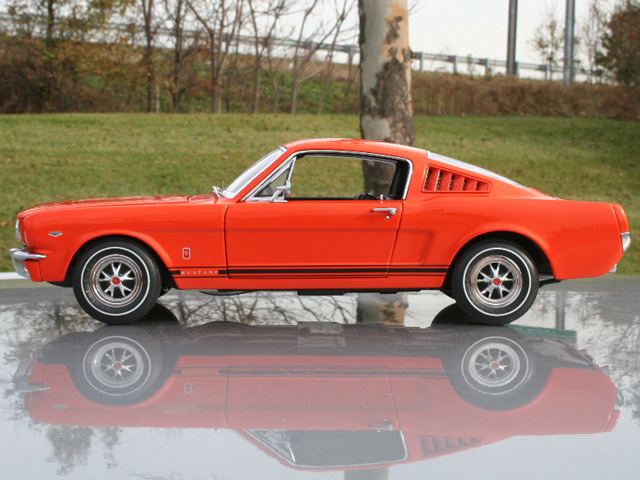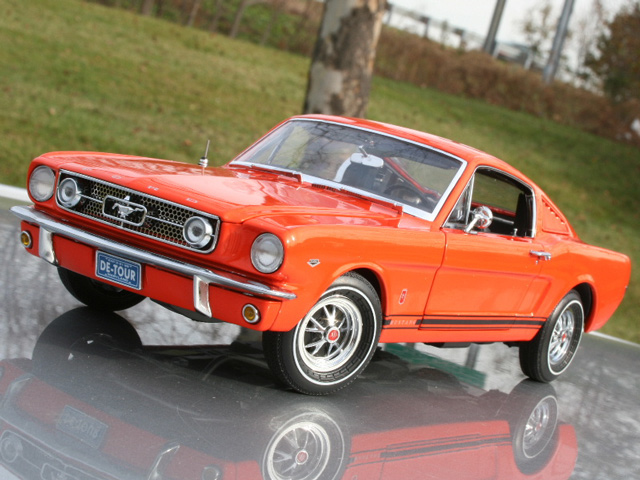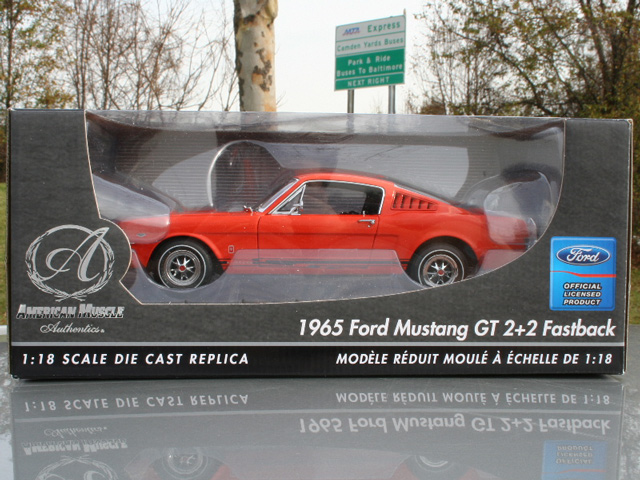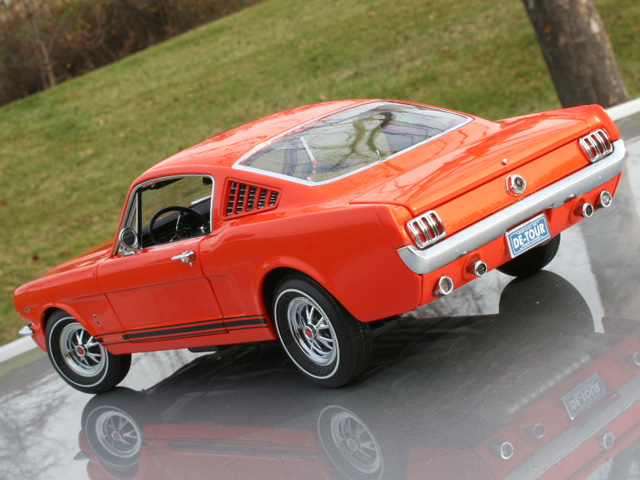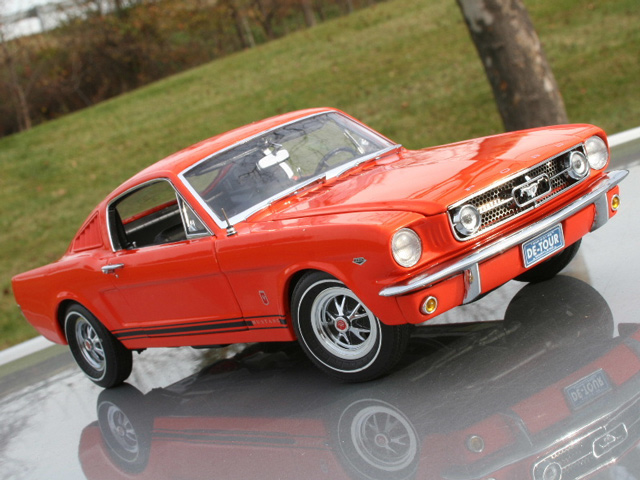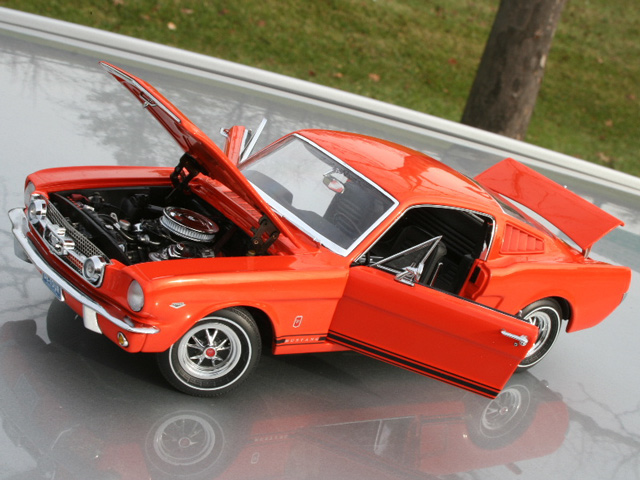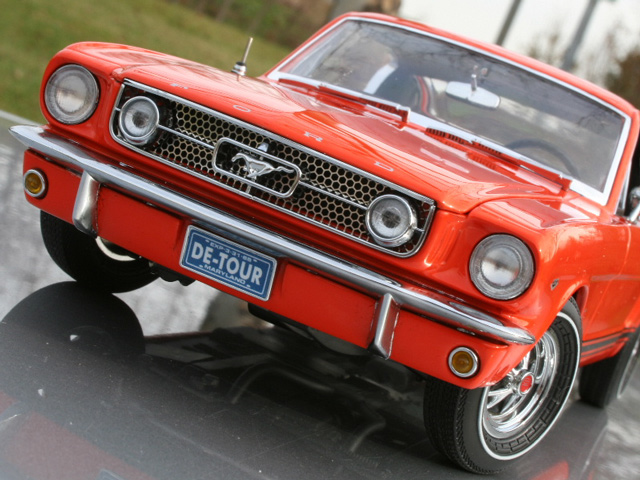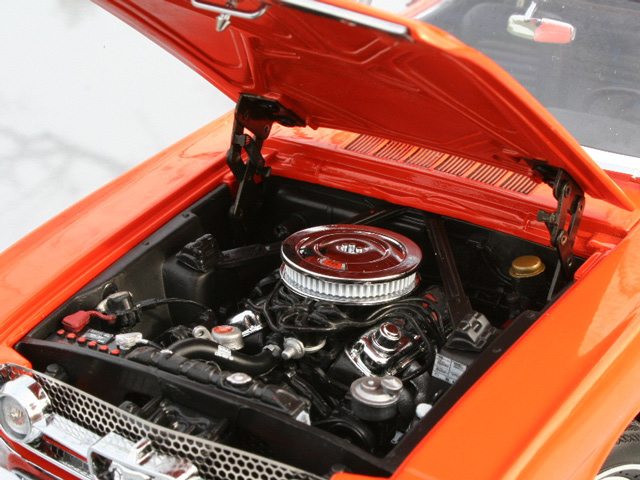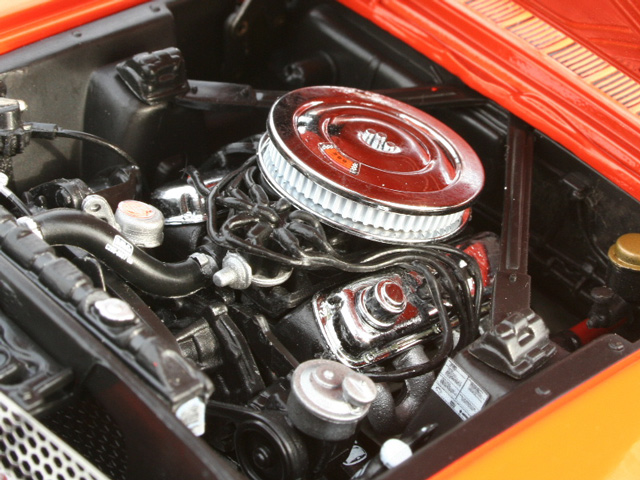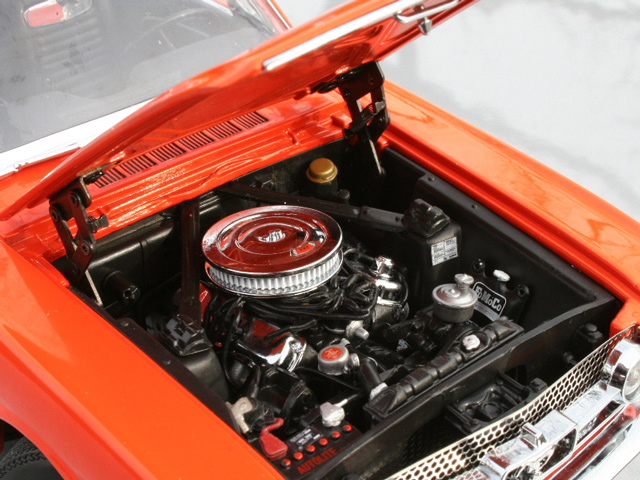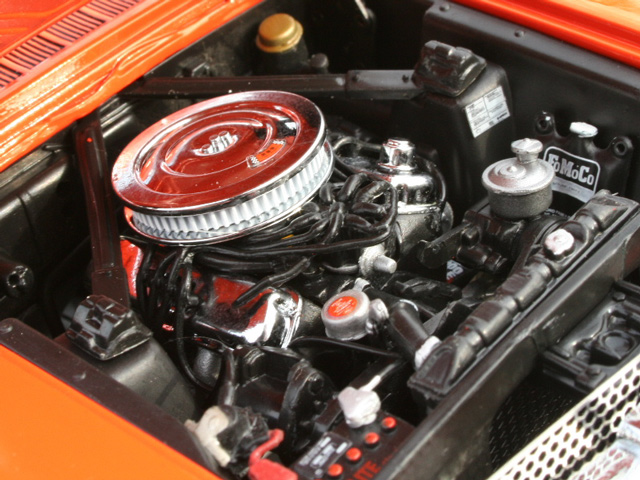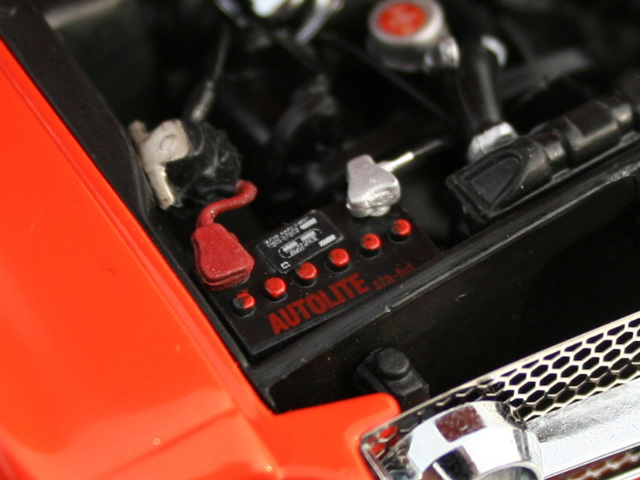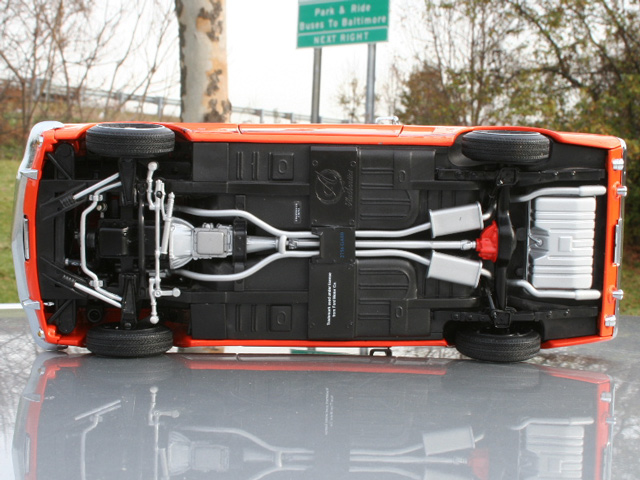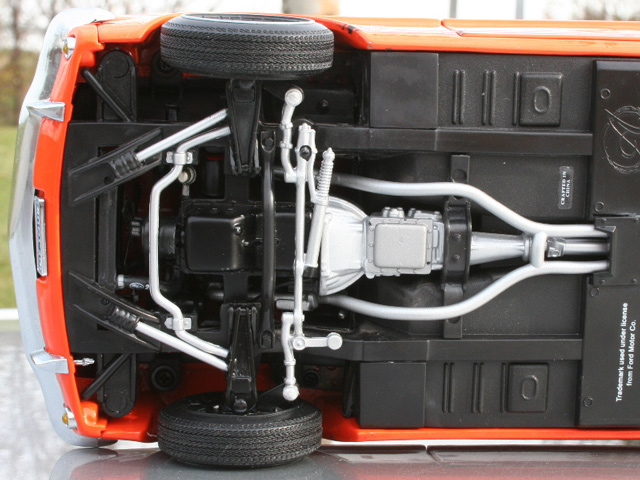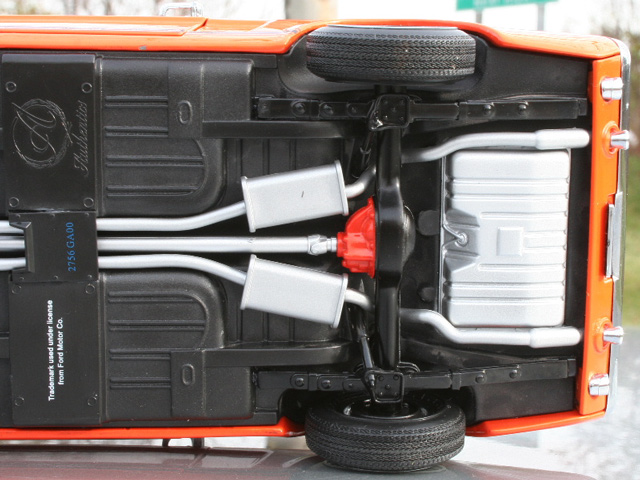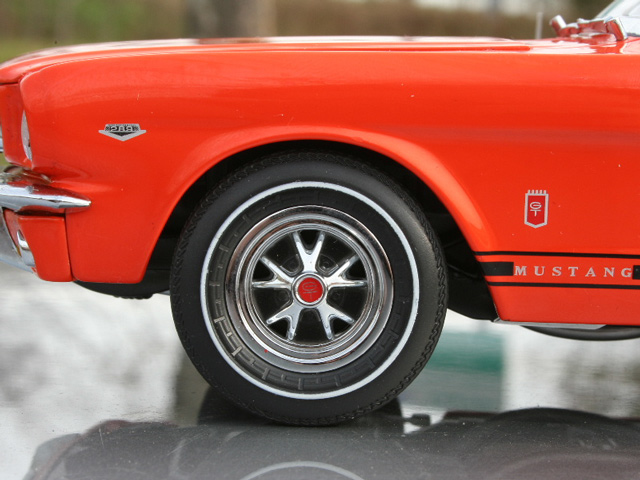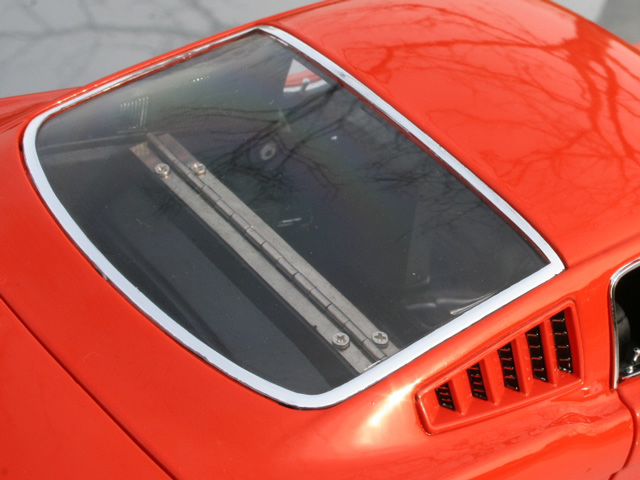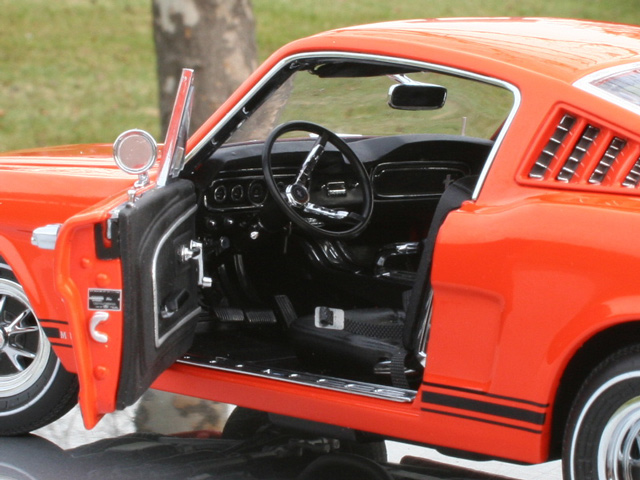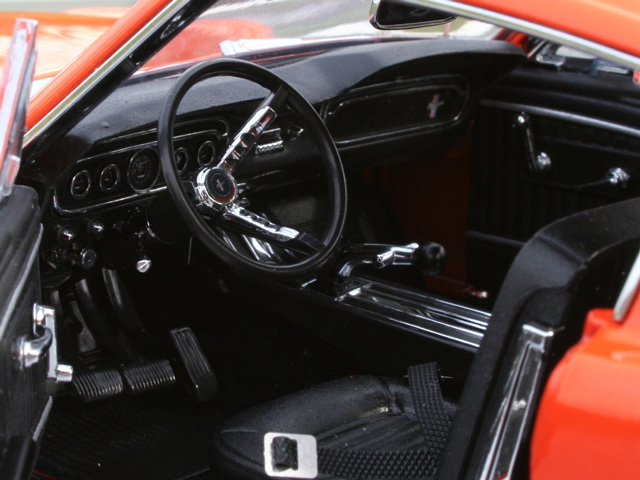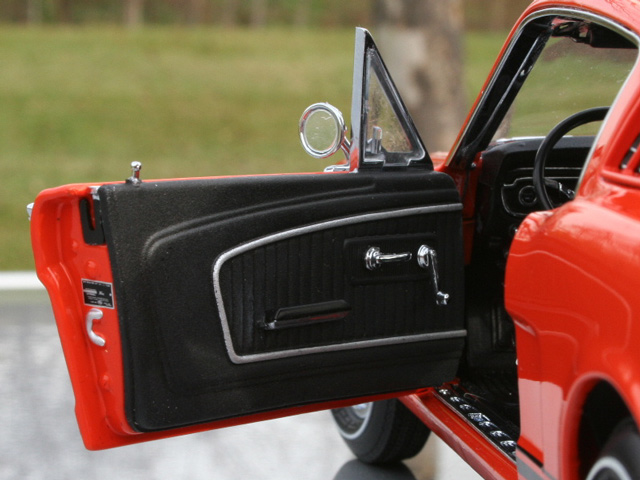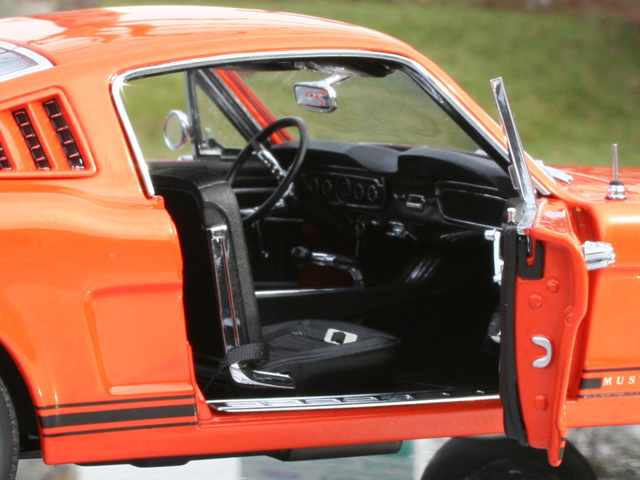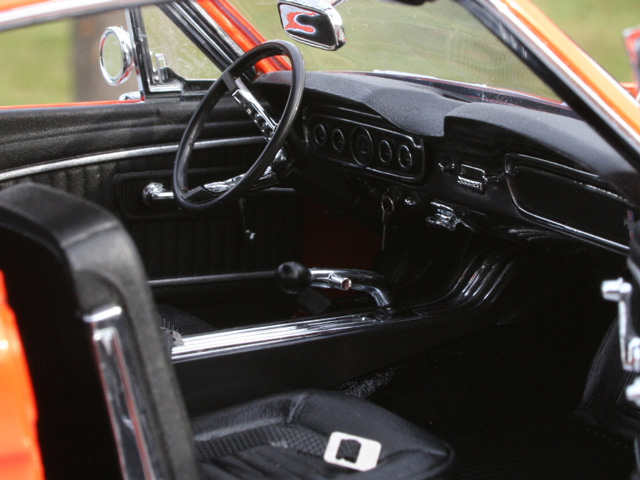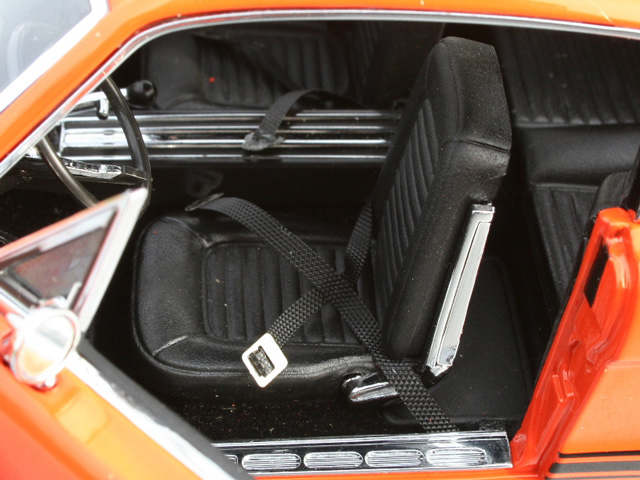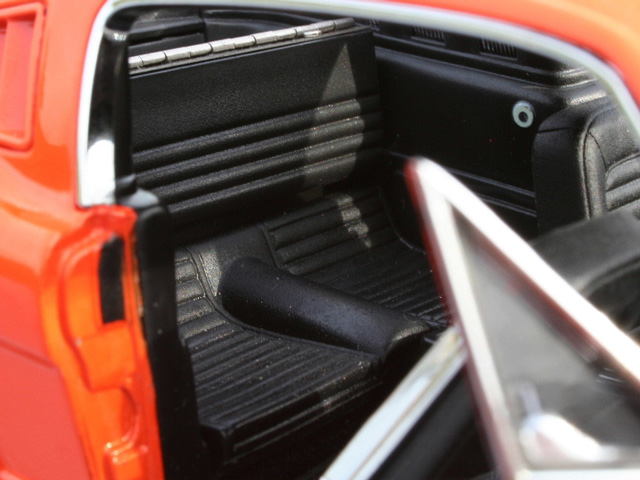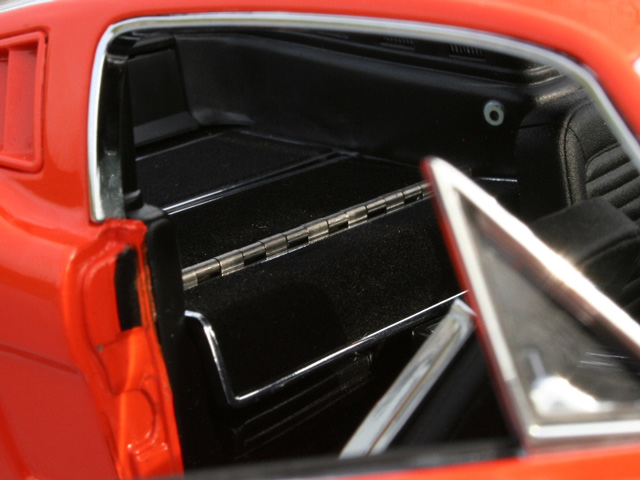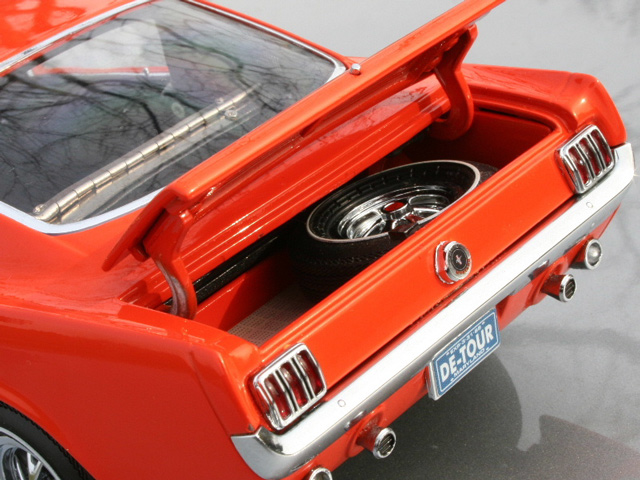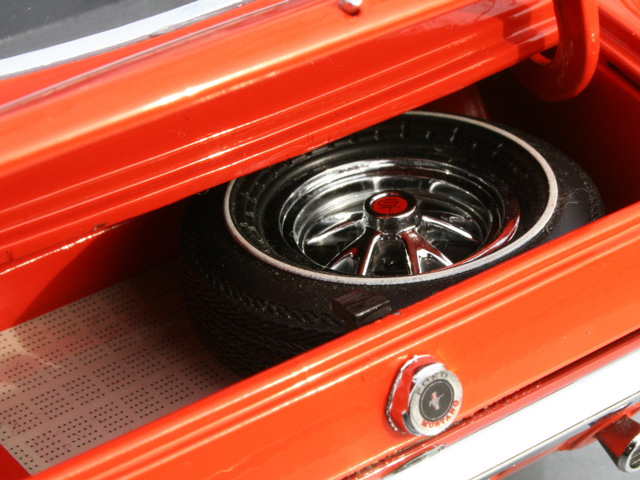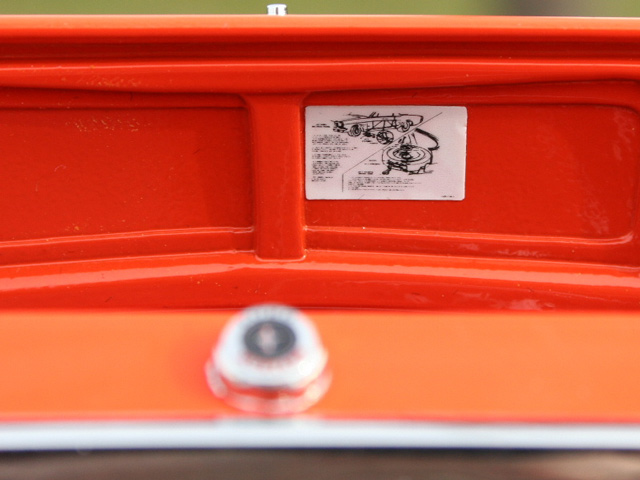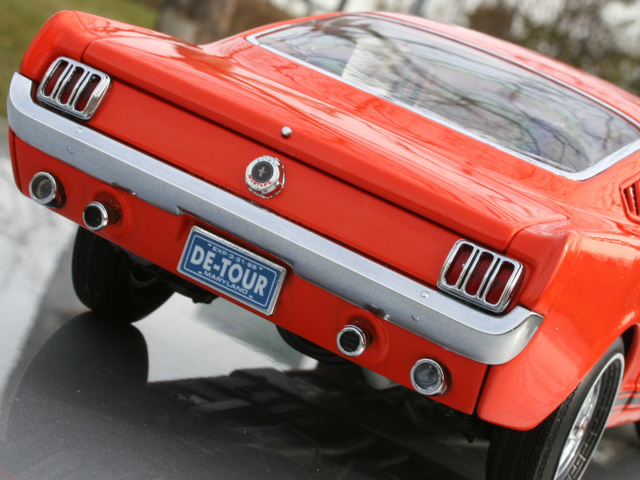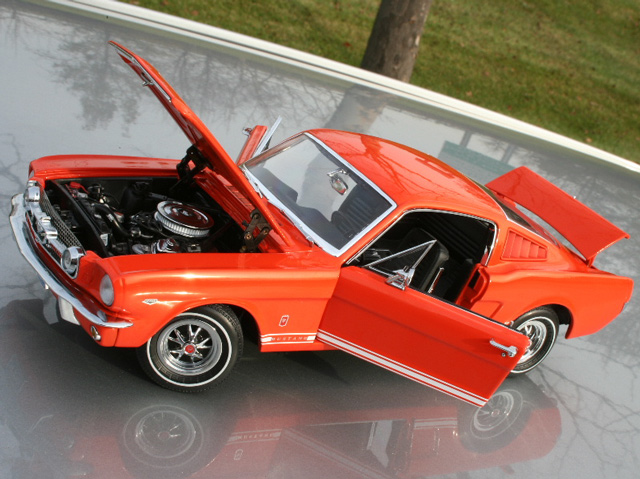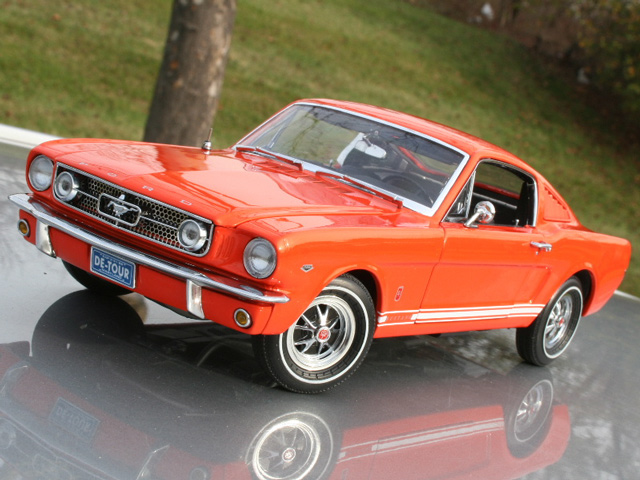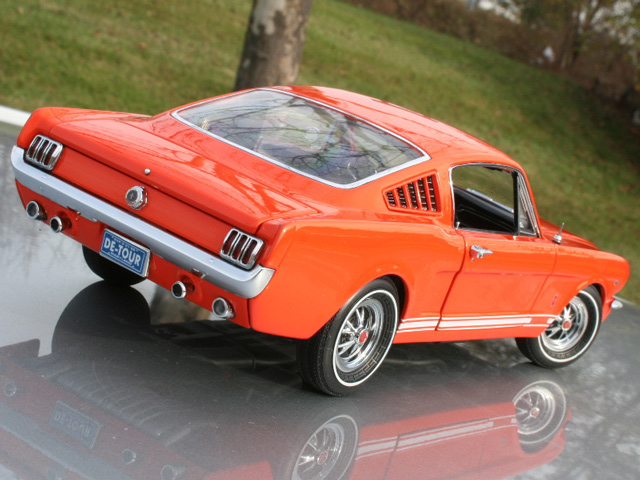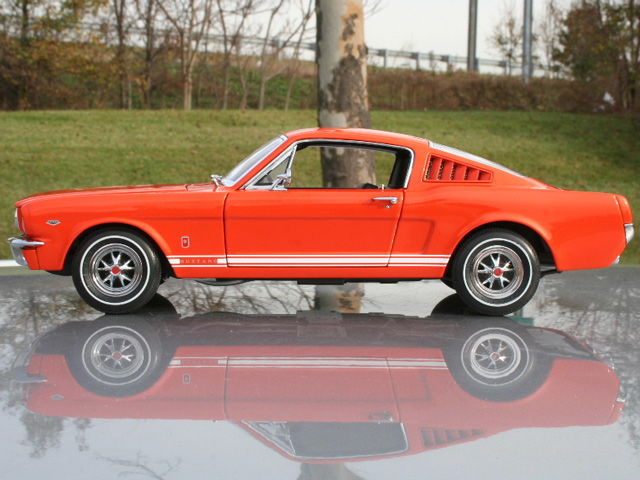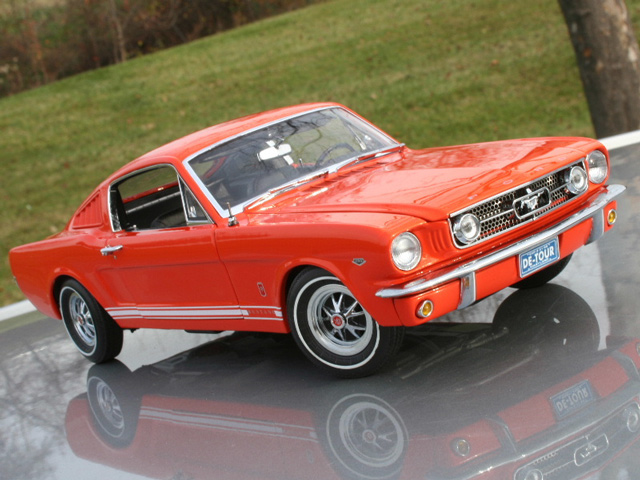 For most Americans, April 17th, 1965 was just another day. 20,000 demonstrators streamed past the White House in the first march on
Washington
,
DC
to protest the war in
Vietnam
and “Stop in the Name of Love” by the Supremes aired on the radio waves as the California Angels beat the Detroit Tigers, 3 to 1. For Ford Motor Company, however, this particular date was of a much greater significance as it marked the one year anniversary of their smash hit pony car, the Ford Mustang.
For most Americans, April 17th, 1965 was just another day. 20,000 demonstrators streamed past the White House in the first march on
Washington
,
DC
to protest the war in
Vietnam
and “Stop in the Name of Love” by the Supremes aired on the radio waves as the California Angels beat the Detroit Tigers, 3 to 1. For Ford Motor Company, however, this particular date was of a much greater significance as it marked the one year anniversary of their smash hit pony car, the Ford Mustang.
Unveiled publicly for the first time inside the Ford Pavilion at the New York World’s Fair on April 17th, 1964, the Ford Mustang literally hit the starting line “full bore” as early advertisements proclaimed. Aimed at the burgeoning baby boomer population, the Mustang combined attractive styling with an impressive list of standard equipment and a mind-boggling catalog of available options, all for an unbelievably affordable price. Bolstered with immediate coverage both in print and television, the introduction of the Ford Mustang caused a near pandemonium unlike anything the automotive industry had ever seen before.
Ford dealers across the country were inundated with orders and by the end of the first day over 22,000 Mustangs were spoken for. Ford Motor Company initially projected first year sales figures for the Mustang around 100,000 although Lee Iacocca’s ambitious “417 by 4-17” prediction called for 417,000 Mustangs to be sold by April 17th, 1965. By that date, the count registered at 418,812 - breaking Ford’s first year sales record set by the Falcon in 1960.
Although the success of the Mustang turned out better than expected, Ford had the foresight of knowing it wouldn’t be long until pony car customers would begin asking for more power, better handling, and fresh styling among other things. In June, 1964, before the end of the Mustangs abbreviated opening model year, Ford engineers unleashed the “K-code” High-Performance version of the 289 V8. Harnessing Iacocca’s “Total Performance” company image, the high-revving solid-lifter Hi-Po K-code 289 produced an impressive 271-horsepower at 6,000-rpm, a full 60-horses more than the 210-hp D-code 289 that would be replaced by the A-code 225hp 289-4V V8 in 1965. Topped with a 600-cfm Autolite 4-barrel carburetor, the 271-horse Hi-Po 289 was capable of launching the Mustang from 0 to 60 in the neighborhood of six seconds with mid-14’s in the quarter mile, reaching top speeds of over 100mph.
The bottom-of-the-line V8 was the common 200-hp 289-2V which replaced the 164-hp 260-2V used in the 1964-1/2 Mustang. The standard 120-hp 200-ci 6-cylinder replaced the weaker 101-hp 170-ci straight six. In addition to a revamped engine lineup, the DC generator charging system was replaced with an alternator. A 3-speed manual transmission was standard with every engine except the 271-hp High-Performance 289 which came equipped with a standard 4-speed manual that was optional on the other models. An optional Cruise-O-Matic 3-speed automatic transmission was also available.
Any Mustang ordered with one of the three available 289 V8’s also received the Special Handling Package which included heavy-duty springs and stiffer shocks as well as a larger, beefed up front stabilizer bar. Mustangs with the K-code 271-hp High-Performance 289 V8 were also outfitted with a heavy-duty rear end differential with a 9-inch rear axle ring whereas all other Mustangs employed a smaller 8-inch ring. Axle ratios were limited to the buyers’ choice of 3.89 or 4.11:1.
Following in August of ’64, kicking off the introduction of the 1965 Mustang, Ford announced the addition of a 2+2 fastback body style. Joining the hardtop and convertible models, the graceful fastback design gave the Mustang the flair of a European sports car, but without the cost. The design incorporated a large swept back rear window, 10 square-feet in size, which flooded the interior with vibrant sunlight. Beneath the wide sheet of glass was a pair of standard bucket seats along with a 2-passenger deep foam bench seat that, when folded down, created a 35x41-inch platform all the way back to the trunk sill, increasing the normal storage space more than three-fold.
On the C-pillars were cleverly crafted functional Silent-Flo extractor vents that allowed air to freely flow in and out of the cabin, even when the windows were rolled up. Altogether, the Mustang’s fastback look was an instant classic, one that would have a lasting influence on car design for years to come. As seen in a Ford Motor Company advertisement published in the November 1964 issue of Car Life - “If that slippery shape makes everything else within a half mile look homemade, too bad. That’s progress.”
Progress continued all the way up to the Mustangs one year anniversary on April 17th, 1965. In celebration of this milestone, Ford introduced the GT equipment group, further elevating the performance image of the prized pony car. Offered only with the 225-hp and 271-hp flavors of the 289, the GT equipment group was available on all three Mustang body styles - convertible, coupe, and the 2+2 fastback. The Special Handling Package was included as part of the GT option as was quick ratio steering, fade-resisting disc brakes, and a pair of 4-inch grille mounted fog lamps.
Mustangs ordered with the GT equipment group also received dual chrome trumpet shaped exhaust tips, unique GT fender badges, and a triple stripe running from front to rear along the lower edge of the body. Inside, the rectangular speedometer that was standard on non-GT Mustang’s in 1965 was replaced by a five dial instrument cluster that featured a round 140-mph speedometer along with fuel, temperature, amperes, and oil pressure gauges. The five gauge instrument panel was also a part of the Interior Décor Group which became available at the same time as the GT equipment group.
Also known as the Pony Interior because of the raised ponies on the special seat covers, the Interior Décor Group included a wood-grain steering wheel along with wood-grain appliqués on the instrument panel, glovebox, and optional center console. Padded sun visors were also part of the interior package as were special door panels that included integral arm rests and pistol grip door handles. Buyers could further dress up their Mustangs with the Rally Pac option which bolted a tachometer and clock to the steering column. Red band or white line tires were also available as were styled steel wheels.
The Mustang was an extraordinary automobile that delivered the performance and style of a sports car at a price almost anyone could afford. By the end of the 1965 model year, the Mustang had captured the hearts of 680,989 drivers with 126,538 pony cars sold during the “1964-1/2” timeline and a grand total of 559,451 copies sold in ‘65. It was a phenomenon that has since become a thing of legend - one that’s still alive some 40 years later and has made the Mustang a pillar of the automotive community. The early Mustangs are still widely popular to this day with enthusiasts and car collectors alike, and they’re record stands as one of the best selling automobiles in Ford’s 100 year history.
In early 2000, Ford Motor Company and
Dyersville
,
Iowa
based RC2 teamed up to create an assortment of high detail 1:18 scale diecast replicas in commemoration of Ford’s 100th anniversary in 2003. This line of replicas, known as the Precision 100 collection, was a tribute to some of Ford’s finest accomplishments in automotive design, engineering and innovation over the last century. An attractive Rangoon Red 1964-1/2 Mustang convertible marked the first release in the series, issued in late 2000. For many collectors, the little red pony car was the first replica to introduce such features as realistic hood and door hinges, movable sun visors, and a rotating driveshaft along with a level of detail that was equaled by very few models of the day.
Six years later, the molds behind the bar raising Precision 100 Mustangs have been resurrected - now a part of RC2’s Authentics series - and with some newly tooled parts and body panels, the 64-1/2 drop tops have been successfully converted into a charming series of 1965 Fastbacks, the latest of which happens to be a breathtakingly beautiful Poppy Red ’65 Mustang GT. The shape and stance of RC2’s 1/18-scale interpretation looks to be quite accurate overall and the fastback roofline is darn near dead on to the real McCoy. Each of the opening panels have a nice fit in the closed position and the paint on my sample is without blemish.
While this ’65 GT looks drop-dead-gorgeous in its juicy Poppy Red finish, the shiny accents - like the wing-shaped wraparound front bumper and backside counterpart that lines up flush with the body - are equally attractive. No bare metal foil here, this is the good stuff. The front & rear glass and side window openings are each trimmed with actual chrome plated parts. The vent windows are further detailed with a thin border of faux weather stripping. A chrome plated competition style gas cap - with Ford Mustang lettering curved around a pony emblem - is positioned between the vertical tri-sectioned taillight lenses and nestled in the honeycomb front grille, between the GT’s accurate 4-inch fog lamps, is a shiny galloping pony medallion.
You’ll also find a pair of High-Performance 289 badges and GT crest emblems which have been tampo printed in their proper locations on the front fenders and the characteristic triple stripe with Mustang lettering runs along the lower rocker panel between the front and rear wheel wells. While the standard color for the lower stripe is black, on the limited production chase version, the stripe is white. The Mustang’s well-dressed appearance is finished off with a pair of brilliantly sculpted extractor vents recessed in the C-pillars that bookend a sprawling plastic rear window in addition to a set of white line rubber shoes wrapped around styled steel wheels with GT center caps.
As suggested by the fender badges, resting beneath the Mustang’s realistically hinged hood, just waiting to be uncovered, is a remarkable rendition of the 271-hp K-code High-Performance 289 V8, accurately finished in black and featuring the Cobra Dress Up kit which consists of a pair of chrome plated valve covers and a chrome plated open-element air cleaner lid. Incremental daubs of paint add credence to numerous other details, both small and large, from the hose clamps and master cylinder to a genuine Autolite battery which has been assembled with the proper cables, one of which is routed to a miniature starter relay fastened to the inner fender wall. Adding further to the realism are authentic part numbers and “FoMoCo” tampos that have been applied to the various hoses as well as the windshield washer reservoir bag.
All in all, I’d say the engine bay still scores big after six years, but it’s not perfect. Most of the parts that were present on the 289 in the 1964-1/2 Mustang made an encore appearance in 1965, but one item some pony car experts will likely take issue with is the generator charging system which was replaced in ‘65 with an alternator. It’s not an oversight on RC2’s part, but more of a side effect caused by the necessity to utilize existing parts to produce the ’65 fastback. Without them, this project may have never become a reality. To that end, I’d say it’s a worthy sacrifice, especially when you consider the many other positives the engine bay has to offer, like the one-piece export brace, the service decal applied to the left shock tower, and the fully wired distributor which is complete with a vacuum advance canister - just to name a few.
Inside the Mustang’s black cabin, you’ll find more than a few things to keep your eyes and fingers occupied. For starters, check out the movable sun visors and the soft-to-touch bucket seats that fold and slide back and forth on the fully carpeted flooring. It was cool then and it’s still cool today. The seats are further detailed with woven belts and photo-etched clips while the floor is decorated with chrome sill plates with Ford blue oval badges and a set of rubber floor mats, each of which is accented with an embossed galloping pony. You’ll also find a center console riding on the tranny hump, trimmed in chrome with an integrated 4-speed manual shifter.
Moving on, the realistically hinged doors feature painted door latches and a scaled data tag on the drivers’ side door. The door panels are detailed with silver painted accent trim and chrome plated door locks as well as chrome plated handles and window cranks that are movable. If these minute details are the kind of thing that tickles your fancy, then you’ll enjoy the emergency brake pull handle and vent knob positioned on the underside of the dash next to the steering column. To the right is a photo-etched key in the ignition, a feature that was common on the earlier Precision 100 replicas. Atop the column is a chrome plated 3-spoke steering wheel with a pony emblem on the horn, behind which sits a copy of the GT’s 5-gauge dash face with the round speedometer.
Perhaps the neatest feature you’ll find inside the cabin of the Authentics ’65 Mustang fastback GT is the rear bench seat that folds down in two sections on miniature precision cast hinges, creating an enlarged, fully carpeted storage space, just as you’d find on the original Mustangs of the day. At the rear of the interior is a hatch door that flips up, granting access to the Mustang’s trunk area which can also be reached by way of the opening trunk lid. The space itself is rather small, which was the case with the actual fastbacks. Crammed within the tight confines is a full-sized matching spare styled steel wheel wrapped in its own white line tire. An instruction label can be found fixed to the underside of the trunk lid and a patterned trunk mat lines the floor, although it doesn’t reach from side to side as it should.
Upon flipping the Mustang on its lid to inspect the belly, you’ll find the same fanfare as found on the prior Precision 100 64-1/2 Mustangs, but that’s not necessarily a bad thing. The front wheels turn, the suspension works, and although the novelty of a driveshaft that rotates in unison with the rear wheels has worn out a little since its introduction, it’s still a nifty feat of engineering. The only issue here is the 3-speed Cruise-O-Matic transmission mated to the other end of the driveshaft. It wouldn’t have been a problem if this Mustang were set up with an automatic shifter, but since it’s equipped with a 4-speed manual - which was the only transmission option available on the Hi-Po K-code 289-ci V8 in 1965 - the automatic tranny is sadly out of place.
Unfortunately, this is another consequence of having to use existing parts to produce these ’65 Mustangs and a manual transmission was never tooled up when the Precision 100 ponies were first assembled. RC2 is fully aware of the problem and fortunately they’ve come up with a solution to the problem which hopefully we’ll see employed on future models. On the upside, the chassis has its redeeming qualities, most notably of which include the splashes of paint that accurately highlight the sway bars and rear end differential as well as the gas tank and dual exhaust system which exits through a pair of chrome plated trumpet tips, another feature of the GT package.
All in all, RC2’s 1:18-scale Authentics 1965 Mustang GT fastback is a pleasing acknowledgment to the one that pioneered the pony car genre and inspired others to follow in its path. It might not be 100% “authentic”, but the fact is it’s the nicest 1:18-scale replica of the ‘65 Mustang fastback produced to date. Priced at under $50, like the original Mustang, RC2’s high-detail interpretation offers an exceptional amount of bang for your hard earned buck. If for some reason the attention grabbing Poppy Red version doesn’t do it for you, RC2’s Authentics 1965 Mustang GT fastback is also available in Springtime Yellow with a black interior. Whether you’re a Mustang enthusiast or simply a fan of muscle cars in general, you won’t want to miss out on either of these outstanding Mustangs. Happy Collecting!




